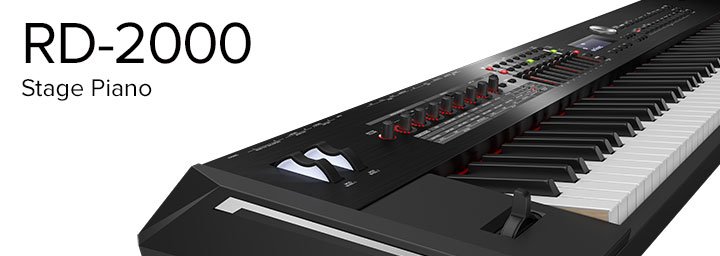The RD Series of digital pianos has attracted attention globally for decades. From the start, Roland has always strived to create the ultimate electronic piano feel and sound. This has been clear from our earliest days, beginning with the release of the legendary EP-30.
Appearing just two years after Roland formed in 1972, the EP-30 was a groundbreaking instrument. It was the world’s first touch sensitive electronic piano. Today, detecting velocity sensitivity from soft to hard playing is standard technology in digital pianos.
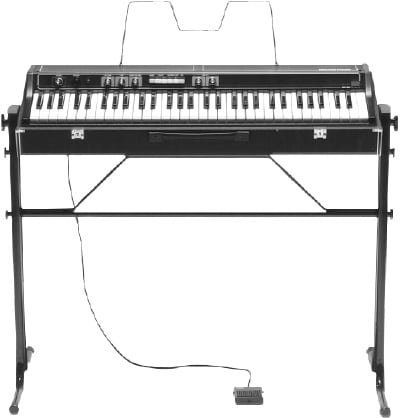
Roland’s RD Stage Pianos are no exception to our vision for electronic pianos that adhere to a superb standard. Stemmed in 30 years of history, the first instrument in the RD series of pianos was the RD-1000. This was an undisputed breakthrough in digital piano technology.
This legacy of quality and commitment continues in the latest addition to the RD series – the RD-2000. Merging the most appealing and innovative features of the RD line to date, along with some of the finest additions to Roland synthesizers. The RD-2000 is the pinnacle of electronic piano technology, feel, sound and playability. But how did the RD series get to this point and what makes it so revered?
Contributed by David Whitehead for Roland Corporation Australia
NEW GROUND WITH A NEW SOUND
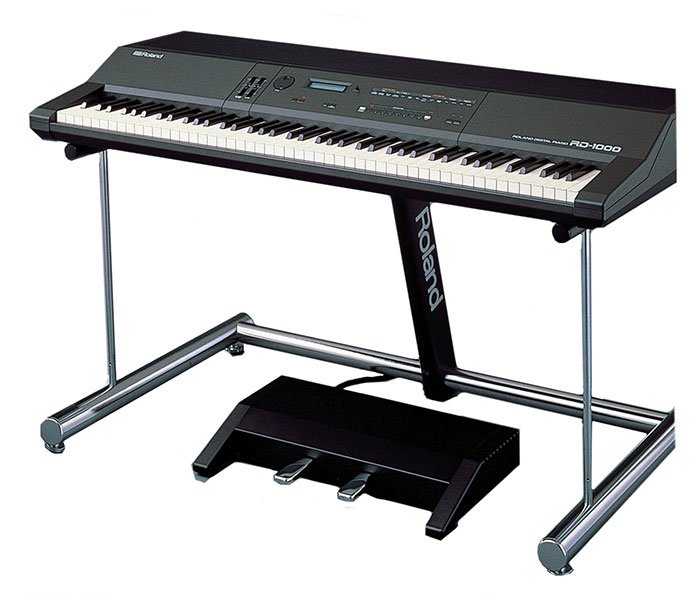
In the early days of synthesis, it was very difficult to produce a realistic piano sound. However, the release of the RD-1000 in 1986 overcame this barrier. This was achieved with the introduction of Structured Adaptive Synthesis (SAS). By dividing the keyboard into 30 zones, the ability to focus closely on different pitches, brightness and harmonic string interactions (i.e., enharmonic relationships) increased. This innovation was a huge advance in digital piano realism. The RD-1000’s 88-note weighted keyboard with solid wooden keys had a very natural playing feel. Importantly, the onboard three-band EQ, Chorus and Tremolo gave performers hands-on control to shape the electric piano sounds. The RD-1000 also had three different key touch settings. These adjusting the feel of the piano for soft, medium and hard playing.
The module version of the RD-1000, the MKS-20, became a Roland classic as well as a staple piece of kit in studios around the world.
There were also two junior models released, in the form of the smaller RD-200 (76 keys) and the RD-300 (88 keys).
The RD series of pianos benefit from consistently keeping live performance at their fore. Exemplified by the Voice Preserve function on the RD-1000, Voice Preserve puts the instrument’s diverse sound range at easy access. When enabled, Voice Preserve allows players to select which voice they want to switch to. With this, there will be no change until playing stops, or until release of the damper pedal.
All models in the RD series include MIDI connectivity. This helps musicians who need realistic piano sounds and keyboard action, along with the ability to connect to a synthesizer module or a second keyboard.
THE RD SERIES OF PIANOS – THE REAL THING
In 1987, the RD series of pianos received an update, with the RD-250s and RD-300s. These models featured a new keyboard action, which used lead weights to replicate the feeling of a raised and dropped piano hammer.
The RD series maintained their popularity through successive models, with the electric piano sounds featuring heavily in early house music. The RD-1000 even famously became the go-to piano for live performances by Elton John.

In 1994, the RD series went to the next level with the RD-500. Based on the same concept as the previous models and applying the developing technology of digital keyboards. Impressively, the RD-500 was able to host 121 sound variations, a noticeable development on the RD-1000’s eight presets. The RD-500 also had increased polyphony and a Hammer Action keyboard for increased playing realism. It was considerably lighter than any of its 88 note predecessors.
The RD-500 expanded on the idea of being a live performance keyboard, with some new features designed specifically for the stage. A notable one of these was the TX (transmit). This gave players the ability to create a bank of settings to transmit via MIDI, independent to the settings that the internal sounds used. Using TX parts alongside the instrument’s internal sounds, players could control four different voices with different keyboard ranges and could transpose MIDI values all at once. This enabled people to take control of complex parts and performances, using the RD-500 as the master keyboard.
The RD-500 also incorporated a number of features that had gained success on Roland synthesizers. This included the ability to adjust the envelope, to detune different layers and an adjustable pitch bend lever.
HAMMER TIME
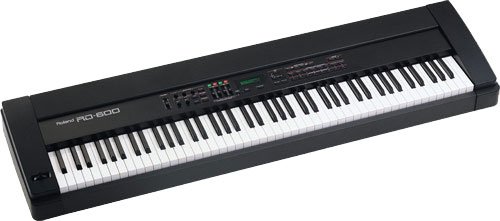
1997 saw the release of the RD-600. Further refining the piano realism now synonymous with the RD series, the RD-600 featured the new PA-4 Hammer Action. It became renowned as being the most realistic action at the time.
The RD-600 also contained an expanded sound set, with sounds from the VE-RD1 and SR-JV80 expansion boards. These were developed for the A-90/A-70 Controllers and the JV-80 synthesizer respectively. The RD-600 also had its polyphony increased to 64 notes. It had 16 parts, further expanding the ability to control multiple voices. Effects on the RD-600 came pre-installed, with specific settings for each patch. This meant that when players dialled effects in, instant optimisation for live playing was apparent.
In 1999, Roland introduced a lower priced RD model, the RD-100. This affordable, 88-note, Hammer Action keyboard still featured nine amazing RD quality sounds with split and layer options. It did not include additional features like the separate MIDI TX section. It made the RD Series of pianos available to a new market of piano enthusists.
EVOLVING THE LEGEND

In 2001, the next big step in piano realism arrived with the RD-700. Its new 64MB stereo sampled wave memory contained a brand new piano and a collection of Roland’s best instrument sounds. It also continued the idea of expansion cards that had been popular in the JV and XV Series. The two SRX slots allowed tripling of the library and tailoring the keyboard to particular sounds that the user wanted to focus on. The RD-700 also introduced a much larger collection of rhythms to play along to. There was also an arpeggiator with 45 styles, including guitar strumming. This was particularly useful for solo artists and bands who played many different types of music.
The same year, the RD-100 received an update. The RD-150 incorporated some of the new features found on the RD-700, as well as its incredibly realistic piano sound.
The RD-700 went through a few different evolutions. The RD-700SX, RD-700GX and RD-700NX each expanded on the features of the previous model, while retaining the classic RD look and ease for performance. The sound and feel evolved too, making it one of the best playing Stage Pianos on the market.
SUPERNATURAL

The RD-700GX introduced Roland’s SuperNATURAL Piano Sound engine. This drastically changed the resolution of nuanced playing. Previously, playback of different samples provided the basis for electronic pianos, in combination with using a computer algorithm to adjust the pitches for the notes between the samples. The SuperNATURAL engine differed by utilising a separate set of samples for every key. There was also a dynamic algorithm that offered 16,000 different levels for each note. This delivered an incredibly smooth response (most other keyboards had a maximum of 128 levels per key). The RD-700GX also included another major improvement, the PHA-II ‘Ivory Feel’ action with Escapement. Escapement replicates the action of playing an acoustic piano. Pressing a key on an acoustic piano will trigger a little click, due to the hammer hitting the strings. This sensation is replicated on Roland digital pianos and is referred to as Escapement.
Using Roland’s proprietary material, ‘Ivory Feel’ was developed especially to provide the same porous and tactile surface as genuine ivory. Without harming any elephants! This meant that the keyboard had a texture similar to the ivory found on older acoustic pianos. It gave players a realistic and slip-proof feel even in the hottest stage environments, where sweaty hands can spell disaster.
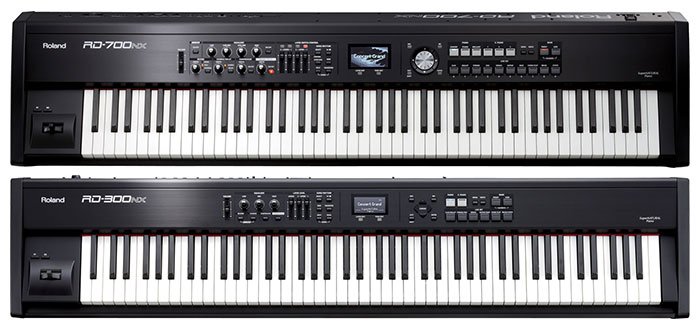
THE RD SERIES OF PIANOS CONTINUES TO SOAR
The arrival of the RD-700NX and RD-300NX ushered in further development of the keyboard action. The PHA-III with ‘Ivory Feel’ keyboard used three independent sensors. These reacted 100x faster than standard sensors, in order to capture the exact playing of the musician.
The NX editor iPad app was also introduced, which made it easier than ever to customise the Digital Piano to the specific stage requirements of any player. It included 50 new synth oriented live sets. These gave an easily accessible visual representation of sound splits, layers and effects settings for each part.

In 2014, the RD series took another leap with the RD-800. The RD-800 has a sleeker look. It is lighter and more portable than any of its predecessors, perfect for the touring musician.
Recommended Article: Command the Stage with the Roland RD-800 Stage Piano
Further enhancing the feel of a quality acoustic piano, the PHA-4 action keyboard offers both ivory feel (on the white keys) and ebony feel (for the black keys). This also included high-resolution sensing technology. The touch, feel and response is quite simply, remarkable.
The unique and powerful Tone Colour knob allows for dramatic alteration of a number of different aspects of the sound, specially optimised for each category. In the electric piano category for example, it can morph between two different classic sounds, allowing the player to find the perfect blend for their song.
CULMINATING INNOVATION► RD-2000
The Roland RD Stage Pianos have continued to evolve over the last 30 years. They have earnt thier global reputation as one of the most realistic, durable and versatile Stage Pianos in the world. Concerquently, they are favoured by many of the world’s finest artists and musicians.
As such, pianists, artists and performers all around the world are certainly feeling the excitement of a new addition to the RD line. Announced in January 2017, the RD-2000 is a dream come true for the performing keyboardist.

THE RD SERIES OF PIANOS DEFINE WHAT IS POSSIBLE
With dual sound engines powering the finest of Roland’s acoustic and electric pianos, along with superb ensemble sounds, the RD-2000 benefits from an innovative modern interface. Dual wave expansion slots allow for additional sounds. The finest action ever in the PHA-50 Progressive Hammer Action with Escapement allows for stunning playability of the internal sounds, or as a master controller for software instruments and external modules. This innovative keyboard features hybrid keys constructed of wood and molded materials, combining classic feel with rugged durability. Together with Roland’s advanced sensor mechanism and hammer-action design, the PHA-50 delivers authentic grand piano touch that’s right at home under your fingers.
Full keyboard polyphony, classic electric pianos from the 60s, 70s and 80s, plus authentic recreations of the legendary RD-1000 and MKS-20 are all features of the RD-2000. As well as the ability to save and recall 100 different snapshot of your keyboard setup during performance, the RD-2000 is equipped with Roland’s new RAINLINK protocol. RAINLINK provides exceptionally high-resolution velocity control for compatible software, which is particularly effective for deriving the subtlest tonal nuances.
With the release of the RD-2000, Roland has achieved the culmination of decades of electronic piano innovation. Further continuing the superb standard already set by predecessors in the RD line, the RD-2000 is the only choice for artists, musicians and touring professionals who demand the finest in playability, reliability and sonic quality.
![]()
This article from Roland UK is a fantastic resource if you’d like to explore the setups of musicians touring and performing with some of the biggest names in music. Various RD models feature quite prominently and it’s loaded with excellent information if you’re looking to build your own keyboard rig.
https://www.roland.com/uk/keyboard-rigs/
![]()
NOTABLE RD USERS
- Elton John
- Toby Chapman (Spandau Ballet)
- Peter Gordeno (Depeche Mode)
- Mike Lindup (Level 42, Earth Wind and Fire)
- Ayo Oyerinde (Jessie J)
- Great Big World
- Brian Culbertson
- Rick Wakeman (Yes, Black Sabbath, etc.)
- Brian May (played RD-1000 at the 1992 Freddie Mercury tribute concert as well as a few other times)
- Floating Points
- Birdy
- Steve Garrigan (Kodaline)
Related Articles
I USED TO PLAY THE PIANO
THE GROUND BREAKING ROLAND PIANO DESIGNER APP
COMMAND THE STAGE WITH THE ROLAND RD-800 STAGE PIANO
INTERVIEW WITH KATE MILLER-HEIDKE

